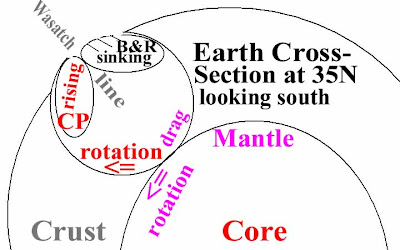
As we complete our weekly hikes, I will place photos and Google Earth analyses for the pertinent features trekked in the field. Here is the initial hike and a model for the various movements of the Colorado Plateau- Basin and Range borderlands:

Below are photos taken during the Nov 4 hike, for fetures which we will hike to see in more detail later:


We will use the models shown below to have a plan of search for pertinent features:


We will be looking for anomalies, such as shown below:


We will be hoping to find laterally-lineated SLICKENSIDES, which show not only the horizontal movement of circular-rotating Coriolis cells, but the direction of movement, as shown below:


The hike on Nov. 11th produced the following photos and analyses. There are blocks of monzonite, which have been sheared by the CW-moving fault along I-15 freeway, via its secondary Coriollis rotations (reactionary cells). This action produces slickensides, which only are considered when found to move laterally (as indicated by horizontal striations).


Continuing to the south, along the B&R fault, we investigate the scarp to the south of the town of Harrisburg.

Above is a photo of lateral faulting, occurring in the Harrisburg, UT vicinity- a shear zone created by the CW rotation of the B&R fault. Below shows the area where this occurs. Note the canyon tracing parallel to I-15. This area will be hiked again, to search for other slicks yielding evidence of the direction of movement.
 Search for slickensides will be made along the canyon paralleling I-15, since this is the gouge and shear zone for the B&R lateral fault.
Search for slickensides will be made along the canyon paralleling I-15, since this is the gouge and shear zone for the B&R lateral fault.
This section of the blog will be used to show recent evaluations and remarks about hikes during the 2009-10 season. This will continue through May 2010.
No comments:
Post a Comment